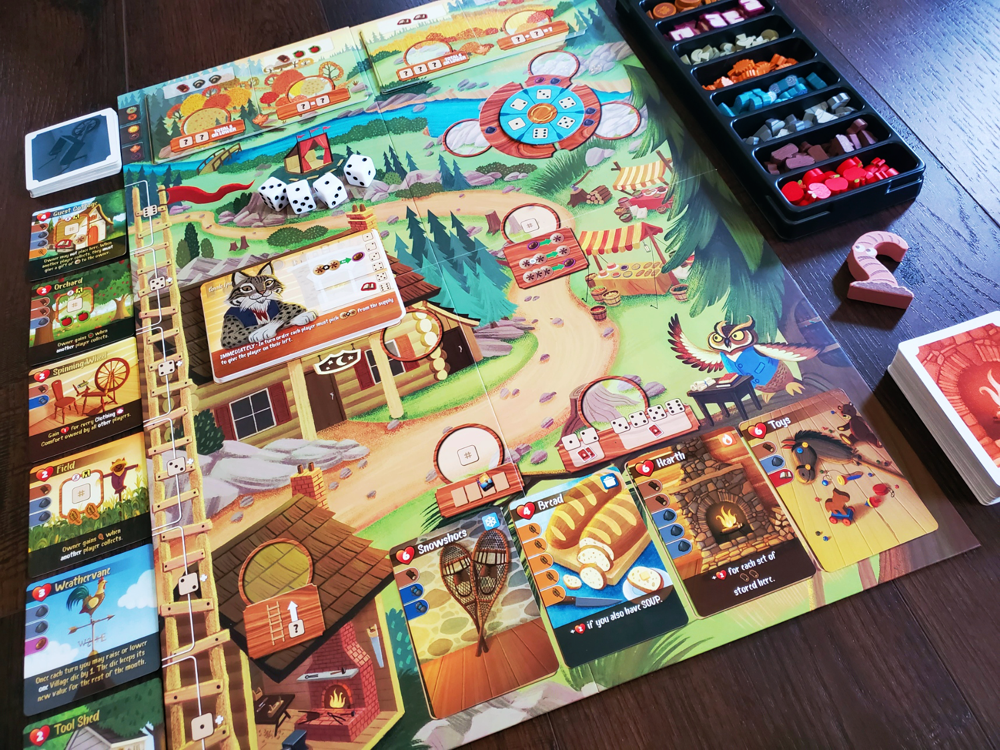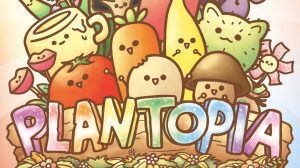Our firstborn were twins. Fraternal twin boys. The last fourteen years have been quite the ride, especially since we’ve added a few more kiddos to the mix. If you met the boys independently and a day or two apart you might guess they are brothers. You might not. We have had acquaintances who were shocked—after months—to find that they were born only two minutes apart. At the time of writing, one (the younger) is a few inches taller than the other. In face and personality they are quite different, but I assure you they are twins. They have quite a bit in common when you strip away the externals.
Consider as a contrast a doppelgänger—one who presents the same externals while hiding more unique DNA under the surface. This is the sort of phenomenon that causes us to say, “I totally think Sebastian Stan could play Luke Skywalker.”
Board games are born into both categories. Take, for example, Cat Lady and Dog Lover, the card-drafting games from AEG. Having put them both on the table, it is obvious that the two titles are related. Though they are as different as cats and dogs in terms of theme, they bear a lot in common under the hood. They have different designers and different artists, but they are built on similar mechanics with just enough twists to call them unique siblings. Fraternal twins.
On the doppelgänger side, consider Creature Comforts from Roberta Taylor and Kids Table Board Games (KTBG), which is perhaps unfairly compared to a certain other game that shares the theme, aesthetic, and a few mechanics surrounding cute and cuddly woodland critters. In the interest of allowing Creature Comforts to shine on its own merits, I’ll hold off addressing the comparison until the end, but I’ve already tipped my hand as to how I believe the games are connected.
For now, let’s dive into our burrows, holes, and dens to prepare for winter by gathering the sorts of comforts that might make me want to live in a more natural setting.
The lay of the land
Creature Comforts largely takes place on the central board in a lively countryside setting called Maple Valley which features seven distinct locations. Each location provides either resources or activity that will enable players to gather, trade, and spend their way to a cozy winter full of Comforts. There are four decks to shuffle, and a bevy of resources to arrange in preparation. I cannot recommend enough the Kickstarter version which comes with wooden resources and a handy tray for organization and ease. They add grandeur and simplify the setup!

Players are provided a House board, a set of Cottage tokens, Family dice, and critter meeples to use as Workers. With the bulk of the game being the crafting of comforts, each player also receives three Comfort cards from which they keep two.
The general flow of the game is wrinkled, but those wrinkles are what gives Creature Comforts its character. Players each have two colored Family dice that match their critters. At the start of each Month (round), these are rolled and placed on the House board as a down payment of sorts to pay for the various worker locations around the board. More dice are coming, but not before a few interesting decisions.

Based on the incomplete information, players then place their four Worker meeples into the seven possible locations. Each location requires a payment of specific dice or dice patterns, so the decision-making involves a lot of speculation. I need a five and a six to gather wood and fruit from the Forest. I’ve already rolled the five. Should I take the chance that we’ll roll the six? Chances must be taken. Hearts will be broken. This tension is the beautiful heart of the game.
After the workers are placed, four community Village dice are rolled, giving each player six total dice to assign as payments for their Worker locations. Every satisfactory payment yields fruitful results. Every failure yields a Lesson Learned token. These tokens can be used in later Months to modify dice by ±1.
The board’s locations help players seek some combination of wood, stone, fruit, mushrooms, yarn, wheat, coins, or books. Rotation is the key feature on the board. Cards rotate out, reshaping the locations with each passing season. Comfort and Improvement cards are also on the move, revealing the game’s variety and opening crafty and lucrative scoring doors. Other locations offer trade as a means of acquiring that oh-so-right combination. The decisions here are always interesting.

Each player turn rounds out by crafting Comfort cards into their display and cleaning up the activity for the next player. At their core, Comfort cards are simply worth points, but they work in combination with one another and with the Improvements to create strategic considerations. After each player has had a turn, there is a bit of upkeep to unleash the variables that will determine the decision points for the next round.
The game can be played over eight Months using all of the available Valley cards or six Months, removing two cards each from both the Forest and Meadow sides of the Valley. When winter arrives, the game is over and players score their Comforts, Improvements, and leftover resources on the way to determining the most successful family of critters who is named the undisputed winner of the long winter’s rest.
Different DNA
Creature Comforts rises and falls on the strength of speculation. Making decisions based on the partial information of the dice is pretty thrilling. It is possible to play safely and achieve most if not all of the Worker placements throughout the game. I have managed to play at least one game in which I learned not a single lesson—but I lost. The beauty of the speculation mechanic is in both rewarding risk and compensating loss. Playing it safe just doesn’t work because it accomplishes neither. Instead, bland decision-making creates bland results. I think this gentle shove into excitement is brilliant.
The rest of the game is a matter of timing. Players must strike when the countryside iron is hot. When the Family dice roll opens a door even slightly to a substantial payoff, Creature Comforts says, “You’ve simply got to try.” Remaining attentive to player turn order can fuel Worker placement decisions about House Improvements and Comfort cards and lead to fun payoffs. Utilizing the Market for timely trades to combo Comforts is so satisfying.
Successful Workers can be resolved in any order, utilizing the spoils of one location to pay off another. There are machines within the machines that beg thought. This can slow the pace momentarily in the Worker placement phase, since planning a sequence of four events can be daunting. Then again, it can also be quite the breeze when the cards line up to shine a light on the path.
Despite the cutesy character of the board, there are just enough cogs in the works to make Creature Comforts a unique gem.

As for comparisons, despite the occasional comments I’ve seen from the Kickstarter to the table, I can say with confidence that Creature Comforts is NOT Everdell. Here are two clever critter games that work through seasons to collect resources by placing workers in order to lay cards into a personal tableau. Doppelgänger? Sure. Twin? I’d say no. As a guy with a love of critter games and a slightly unhealthy infatuation toward Everdell, allow me to provide two reasons why these games scratch wholly different itches.
First, utilizing the dice speculation as the game’s nerve center creates a completely different atmosphere around the table. Both games feature interesting decisions in every season, but Creature Comforts is set apart by the necessity of making four potential decisions simultaneously, creating more of a creative cloud than a linear progression.
Second, while both involve gathering resources to buy cards, the cards themselves serve entirely different functions. Rather than building an individual engine, players in Creature Comforts are using the communal countryside engine to craft personal rewards. Yes, those Comfort cards combo for points, but they do not create the same brand of reliance or relationship. Tons of games trade resources for cards, but the way those cards serve the theme and the player makes all the difference.
The mechanical underbelly in Creature Comforts is fascinating for wholly different reasons. As someone who would lovingly knit a cashmere box cover for Everdell if I had any manual dexterity, I can say I enjoy both of these titles for their doppelgänger-ish qualities. I have lots of room in my collection for those visual characteristics. I happen to love them both for their unique gameplay tensions and choices.
The call of the (not so) wild
The Kickstarter edition of Creature Comforts includes two modules that bolster player strengths and loosen up the scoreboard. The Talents module introduces unique player abilities in the form of vocations for the family. Carpenters have the inside track to wood. Grocers find bonus edibles around the village. We’ve found these to be a seamless addition.

I’m still not sure about the Dreams Come True module, which gives small private goals to each player that can be attained throughout the game. Have five or more Lessons Learned tokens at once for four points. Send Workers to all three River locations in one month for five points. These micro-goals are interesting and lucrative. They definitely shift the dynamic, allowing players to focus somewhere else for a load of points—and this is my concern. The module allows for a steady stream of Dreams throughout the game so that players each have two cards at all times, meaning every turn is a chance to do something wacky in the name of slightly off-theme points, only to do it again next Month. If Comforts are the name of the game, then victory by any other name doesn’t seem to smell as sweet.
The box is wonderfully organized. The Deluxe components are top-notch. Every stretch goal from the Kickstarter campaign fits so seamlessly that I couldn’t imagine the game without. Of particular note is the inclusion of three board game Comforts—Fossilis (also from KTBG), Wingspan, and fittingly, Everdell that are so wonderfully lucrative in combination that my eight-year-old won his first game by crafting all three. The artwork from Shawna J.C. Tenney (Wizards of the Wild, Winner Winner Chicken Dinner) is a whimsical delight. From cover to the GameTrayz designed core, the game is a stunner and boasts a welcoming presence on the table.

Gameplay takes longer than the box might lead you to believe. While it is possible to put your head down and plow through the decisions to finish in under an hour, games like Creature Comforts strike me as the sort that demand appreciation. Why rush through something so delightful? Drink deeply. I say enjoy the thing, but that just might require closer to 90 minutes for more than three players if you include setup and clean up.
I’ve read suggestions of tossing more dice in the box to allow more simultaneity in the player turns to cut the time. I suppose this can work, but it also adds a lot of chaos to the table. Most often, after assigning our dice, we resolve the resource collection and then reset the dice for the next person while we work out Traveler shenanigans, Market trades, building Improvements, and crafting Comforts, pulling back Workers along the way to make sure there’s no overlap if turn order comes into play.
On a similar note, I’ve personally enjoyed the shorter six Month length for most of our plays. At this length, players can craft 5-10 Comforts, more than a couple Improvements to their House, make good use of the Glades, and find a few combos to score big with just a hint of pressure. The eight Month play feels like easy wish fulfillment without breaking a sweat. The points simply roll off the wheelbarrow. Rather than seeing the full show every time, I generally prefer to leave certain possibilities in the box to add a touch of variability and challenge. I want to feel like there’s more to be done when I box it up for the night.
In my book, Creature Comforts is a winner. Roberta Taylor and KTBG have built a lovely, even if lengthy, family game, but one that delivers an engaging time. They’ve mitigated the speculation to where it is more joy than frustration and developed a system of increasing capability that delivers a good sense of accomplishment. Our kiddos have loved it. The adults have (mostly) appropriately agonized over it. It sings a happy song on the table and invites another play.
I say it stands tall among the trees.












Add Comment